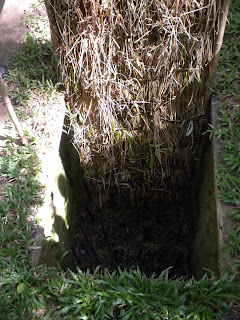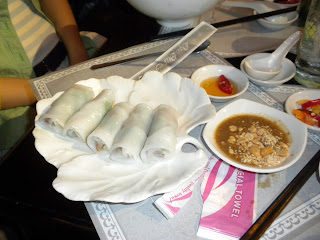This was a very sobering day and really made me think. I’ll start out with some of the lighter stuff and then progress to the deeper stuff. We first went to the Cu Chi Tunnels. For those that don’t know, during the Vietnam War (or American War…more on that later), these tunnels were used by the Viet Kong in order to get around without being seen. The tunnels were actually built prior to World War II, but most people know of them because of the Vietnam War.
Anyways, on the bus ride to Cu Chi I talked with Tin, one of our tour guides/advisors/helpers. I really enjoyed talking with him because he shared his career path with me and how he got into education. As it turns out, he was an IT Engineer and worked for Nortel. When the Vietnam branch closed he switched to an IT job involving technology and now with his job at UEF he has transitioned entirely into the education sector. I think it’s really fascinating to look how people’s lives and careers change over time.
So, the Cu Chi Tunnels. We arrived at this park of sorts and it immediately had a touristy feel to it.
Nonetheless, Dr. Berman stressed that we should remember lives on both sides were lost at this site, and though it was a fun visit, this was always on my mind. It was amazing seeing what the Vietnamese here at Cu Chi did to fight.
Women who worked with sewing machines during the day usually had guns strapped to the wall next to them so that they would be ready to fight. Cooks would have the same thing. Bombs dropped by the American forces were salvaged and recycled. Exploded bombs were collected and their shards were melted and turned into spikes and spears (after leaving craters deeper than I am tall). Unexploded bombs were cut open and the powder reused in another type of explosive while the iron was melted down in much the same way.


I think walking through the tunnels really gave us a feel for just how dedicated these people were. After about 2.5 minutes I felt very claustrophobic and my thighs were burning from walking hunched down (actually they still are..I know, I need to work out more). I’m taller than most Vietnamese, and the tunnels have been enlarged for tourists, but I’m still amazed at how quickly and willingly they would descend into those deep, dark tunnels. The way in which they hid them is amazing too. Entrances were usually very small doors. When someone entered, they went in feet first, covered the door with leaves, and then dropped it into place above their heads. This kept the entrances hidden. False entrances that led to traps were also installed. Kitchen smoke was rerouted to about 100 meters away and vented to make it difficult to detect. Air holes were disguised in termite mounds and kept a few inches off the ground so they would not be blocked off by the rain. In order to keep dogs from finding them, men would use garlic, chilies, or American perfumes. What were probably most disturbing were the tank and the video that we saw. On display was an American tank destroyed by a landmine.









This highlights another lesson I learned from this visit: every war has two sides of the story. At the start of the visit we watched a movie that described the American soldiers as “devils” and talked about all the bad things that they did and how they liked to shoot men, women, children, even Buddha statues. To us this was a bit shocking; however that is what they saw and this is what was depicted in this black and white film. I think another important lesson that we learned from this visit was that both sides were rather gruesome. Some of the awful massacres against the Vietnamese are well documented, but the trap exhibits we saw were the things of nightmares.

After we were done at Cu Chi (and after a wonderful lunch at Cu Chi), we went back to the hotel and walked down the street to the War Remnants Museum. I found the airplanes, helicopters, and tanks to be very interesting, but the largest exhibits were inside in the form of words and pictures. When the “Vietnam War” is talked about in school or anywhere here in Vietnam, it is referred to as the “American War". The museum has many examples of support posters for Vietnam from communist parties in countries around the world, quotes from various politicians, and pictures of bombings and Agent Orange victims. The latter were perhaps the most heartbreaking. I won’t go into too much detail here, but I will say this: If you are ever in Ho Chi Minh City, the War Remnants Museum is definitely worth a visit to get a different perspective on the war as well as to see the military machines they have there if you're into that. A good two hours would be well-spent here and honestly, the price is right.













What is important about all of this history of wars and fighting is that today the United States and Vietnam are closer than ever and we have and continue to overcome our unfortunate past. In talking to Vietnamese people of different genders, ages, and occupations, everyone feels that a stronger bond between the United States and Vietnam will be positive for both nations. From what I’ve seen, I have to agree. The Vietnamese are a very kind, forgiving people and are excited to move forward. Furthermore, the United States recently agreed to work on a sea port for Vietnam, something they need desperately (as well as other infrastructure). They are very excited that we have agreed to do this.
Let’s move on to brighter topics. Dinner this night was at a restaurant called Lion Beer, which for those familiar with Hofbrauhaus is very similar, though minus some of the traditional German cuisine. Nonetheless, this was an excellent meal in a very nice atmosphere of typical Bavarian decorations. This was well worth our amusing cab rides.

















































